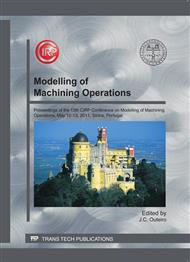p.162
p.172
p.182
p.191
p.203
p.212
p.222
p.231
p.240
Virtual Reality Animation of Chip Formation during Turning
Abstract:
Virtual Reality (VR) technology allows the animation of machining operations. The kinematic of the machining operation and the geometry of the parts are allocated prevalently to VR using the Virtual Reality Modeling Language (VRML). In order to visualize the machining operation close to reality, the chip formation process needs to be animated as well. This paper presents the virtual reality animation of external cylindrical turning considering the chip formation and the results of the machining operation, such as the process forces. The chips are described numerically using JavaScript which is embedded into the VRML. The JavaScript accesses in addition to an experimentally generated database in order to display the results of the machining operation. The turning operation is visualized both in a non-immersive graphic user interface and an immersive Cave Automatic Virtual Environment (CAVE).
Info:
Periodical:
Pages:
203-211
Citation:
Online since:
April 2011
Authors:
Keywords:
Price:
Сopyright:
© 2011 Trans Tech Publications Ltd. All Rights Reserved
Share:
Citation:


